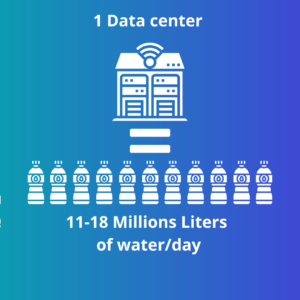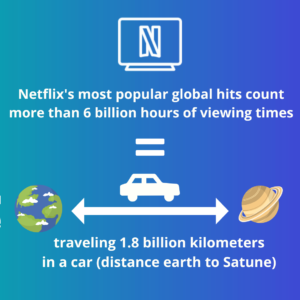Intro
In the fast-paced digital era, it’s easy to overlook the profound impact our online activities have on the environment. Have we truly grasped the danger it poses, or is it an issue we have yet to fully consider? Perhaps it has taken us too long to realize the magnitude of this challenge.
In 2023, a 5.18 billion people will be using the Internet globally. From every search query and Netflix stream to email communication, online file storage, and cloud computing, these seemingly harmless activities collectively pose an imminent threat to our environment. They fuel the ever-increasing global energy demand, resulting in a surge of CO2 emissions and their subsequent detrimental consequences.
Why do we persist in overlooking the fact that simply turning on our computers poses a threat and contributes to pollution?
It’s an alarming reality that digital technologies, as highlighted in a report by The Shift Project, account for around 3.7% of global greenhouse gas emissions—equivalent to the entire aviation industry’s emissions.
What is the Digital Carbon Footprint?
The term “digital carbon footprint” encompasses the greenhouse gas (GHG) emissions produced by digital technology resources, devices, tools, and platforms. Join us as we explore the profound impact of our digital actions on the environment, uncovering the hidden dangers and challenges that demand our immediate attention and action.
The main challenges
Have you ever wondered about the challenges associated with our digital footprint? Which sectors contribute the most to pollution? And are our electric cars really better for the environment compared to the seemingly innocuous forgotten newsletters?
The Hidden Costs of Emails
347.3 billion emails are sent and received daily around the world, according to the latest data, therefore we know that “The Carbon Footprint of Everything” by Berners Lee, estimates that a typical email emits 0.3 g of carbon dioxide. With a hefty attachment, though, this can increase to 50g.

Which, by the numbers, translates to 1.4 billion CO2 per year due to emails. According to this study, Global email usage generates as much CO2 as adding 7 million extra cars on the road.
To go more specific, 203 million emails are sent every minute, generating 816 tons of CO2—equivalent to 895 flights from Dubai to Paris every minute!
One strategy to limit the amount of CO2 generated by your emails is to send fewer useless emails, while the spam that clogs up your inbox may also be a source of emissions.
Approximately 50% of all email traffic is regarded as spam, according to Statista data.
For example, we could cut emissions by 16,433 tons of CO2—the equivalent of 81,152 flights from London to Madrid for instance, if every email user in the UK sent only one less email every day.
Water: The New Blue-Black Gold of Data Centers
In the years to come water is going to be one of our most precious resources and the biggest factor in the world economy if this is not the case today.
When we know that According to the United Nations, by 2025, 50% of the world’s population is projected to live in water-stressed areas making data center water usage a critical environmental stake to prioritize change. Why?
The number of connected devices is on the rise, expected to reach 55.7 billion by 2025. Three-quarters of these devices will connect to an Internet of Things (IoT) platform, generating huge amounts of data. But this data needs to be stored, increasing the demand for data centers.

According to the International Energy Agency, data centers accounted for nearly 1-2% of the world’s energy demand in 2020.
Data centers are entrusted with cooling down the facilities to guarantee damage is avoided because of the excessive quantity of heat that is generated by the processing power that they employ. The usage of cooling requires around 43% of the total electricity utilized in data centers.
Because of the need to cool down data center equipment, these facilities use copious amounts of water which can use in global upwards of 11-18 million liters of water every day (one data center can go to 333,100 Liters/day), which is enough to accommodate the water needs of a city with anywhere from 30,000-50,000 people, said Venkatesh Uddameri, professor and director of the Water Resources Center at Texas Tech University.
The process that data centers use for their cooling system or Humidification system, is comprised of cooling towers, chillers, pumps, piping, heat exchangers/condensers, and computer room air conditioner (CRAC) or computer room air handler (CRAH) units, which will then be evaporated to remove heat from the servers or sprayed into the air around the servers.
Creating a sustainable cooling solution for data centers necessitates a delicate balance between power and water usage. Even though there are cooling systems that can function without the usage of water, they consume a lot of power, making them less sustainable than alternative solutions. As technology develops, the best and most sustainable choice will be one that emphasizes energy efficiency, cost of ownership, and sensible water usage.
The Dark Side of Online Streaming
In our digital era, online streaming has established its dominance over internet traffic. According to research conducted by the Shift Project, streaming online content alone accounts for a staggering 58-60% of internet traffic, resulting in a staggering annual production of 300 million tons of CO2. This equates to approximately 1% of the world’s emissions. To put this into perspective, the average emissions of a passenger on a roundtrip journey from Paris to New York amount to just 1 ton of CO2.

Watching videos online has an inevitable impact on the environment. On-demand video services like Netflix and Amazon Prime account for one-third of all video streaming traffic. As new platforms like Disney+ and others enter the market, this number is increasing yearly. The Covid epidemic has expedited this tendency, and in the past year, the number of people signing up for these services has skyrocketed.
To delve deeper, Netflix recently unveiled insights into its most globally popular shows, including Squid Game, Stranger Things, Money Heist, and Bridgerton. Within the first 28 days of their release, these shows accumulated over 6 billion hours of viewing time. To put this into perspective, research estimates that this is equivalent to traveling 1.8 billion kilometers in a car, roughly the distance between Earth and Saturn.
Another third of it originates from social networking sites including Facebook, WhatApp’s video sharing feature, Instagram’s Reels, TikTok’s Reels, and Youtube.
The final third that you may forget comes from … Adult Video Industry … which is one with the largest negative environmental impact because there are no regulations on it, and millions of videos are stored on these websites. The annual carbon footprint of watching adult videos amounts to more than 82 million tons of CO2 per year! Which represents Romania’s annual carbon balance!
Final words
To sum up, the effects of digital technology on our globe are both serious environmental concerns and a major influence on future global politics and economics. However, may I ask you a question?
By the time you finish reading this, how many emails, Linkedin invitations, or Instagram notifications have you already received? To better understand, the equivalent of 4,475 flights have been launched between Dubai and Paris since you began reading this article. Due to the 1.015 bn emails sent in the last five minutes.
By Elias Seddar
